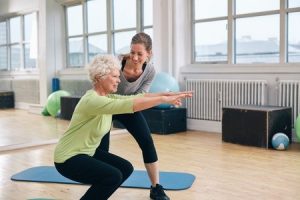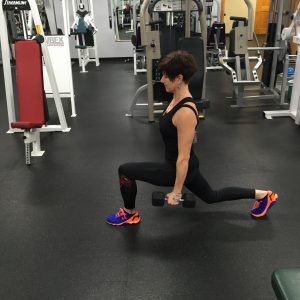Program both open and closed kinetic chain movements for your clients so they get a variety of movements that mimic activities of daily living and sports. Also, well-rounded knee strength.
Squats are an example of Closed Kinetic Chain Exercises (CKCE) because the legs are in constant contact with the floor. Leg extensions are an example of “Open Kinetic Chain Exercises” (OKCE) because the legs are free to move while pulling or pushing a resistance.
Closed Kinetic Chain Exercises and Considerations

The Squat: This is the best exercise to do when the mechanics are correct and pain isn’t present.
Teaching proper squat progressions and alignment corrections is essential because people squat every time they stand up or sit down.
If any knee problems exist there may be discomfort. Differentiating muscular fatigue from pain by communicating clearly with your client is crucial to preventing further damage to the knee.
The role of a personal trainer is to analyze the movement, detect any imbalances or issues and design an exercise program. Proper form while squatting is essential for injury prevention. The most critical cues for squats are keeping the knees, hips, and toes in alignment.
Leg Press: This movement is not as demanding as the squat due to the stabilized nature of the laying position. It is the second most complete and safe exercise for the lower body and strengthening the knees.
Make sure the knees don’t travel over the toes and that the knees don’t buckle inward. Tempo should be controlled with no locking out at the top end of the range of motion. Any visible ballistic bouncing at the bottom should be avoided.

Kelly Bianco
Lunge: This movement mimics the act of reaching forward to pick something up off the floor as you leave one foot back and move one forward as in to step and reach.
Choose the correct modifications for lunges, load, speed and movement pattern according to the client’s unique health history and current abilities. Progress to lunges after mastering a squat or leg press if the client cannot support their own bodyweight.
Open Kinetic Chain Exercises and Considerations
There are different types of forces applied to the knee joint when considering the choice between CKCE’s and OKCE’s. The forces applied to the knee during a squat are termed “compressive forces” which are the forces that a joint can handle and accommodate more safely than the counterpart “shear forces”.
Leg Extension: The leg extension strengthens the quadriceps muscle. However, many experts warn that the biomechanics of this movement on this type of machine places unnecessary stress on the anterior part of the knee. This is because the loading is perpendicular to the long axis of the tibia.
As the joint moves upon contraction of the quadriceps, “shear force” is created which places the knee joint in a compromising position for optimum safety. During the performance of a leg extension, the quadriceps reacts by pulling the tibia forward.
The ACL opposes this action by trying to prevent the translation of the tibia. This phenomenon called tibial translation places a huge amount of stress on the ACL and therefore something to give specific thought to.
Leg Curl: Some argue against the “functionality” of this movement because of the single joint action, which only allows the hamstring to function as a knee flexor. Isolated exercises like leg curls, when performed thoughtfully are the building blocks for functional movement. There is a time and place for both in most exercise programs.
Shear forces are great when performing leg extension compared to squats, leg presses, and lunges. Assess adequately and communicate with your client’s medical practitioner for confirmation and clarification. Use the leg curl cautiously with controlled, non-ballistic movements.
Which Type of Exercise is Better For Knees?
There is a risk to benefit ratio with all exercises. Over the last 10 years since we started to hear the whispers of the “better for your knee” exercise selections, here is what I have found:
For the argument presented, when we think of the shear compared to compressive forces applied to the knee when performing a leg extension versus a squat, leg press or lunge, it is clear that the better of the exercises are going to be the squat, leg press and lunges.
Needless to say, the squat, leg press or the lunge can easily become worse exercises than the leg extension if performed in the incorrect manner. It is up to the fitness professional to coach a client and know how to progress or regress a movement.
There is NO WRONG exercise or movement. There are WRONG applications of exercise and movement.
Below you can find the pros and cons of the movements that have been mentioned in this article.
Knee Extension Pros and Cons
Pros:
- Allows for the beginning stages of rehab in supervised controlled ROM settings.
- Can be used with lightweight for a warm up or finishing movement after the heavily loaded movements are performed.
- Some have reported increased stress on the rectus femoris which becomes something a bodybuilder may want to focus on for aesthetic purposes.
Cons:
- Puts a tremendous amount of shear forces on the knee. Shear forces are harder on the knee than compressive forces, as seen in SLL’s.
- Can’t build muscle size. Muscle size requires maximum stabilization with compound movements to lift the max weight. You cannot lift max weight for muscle size using a single-joint movement.
- Isolates the quadriceps.
- Does not mimic any ADL’s and very few sports (dysfunctional for human movement performance).
- Does not allow for sufficient energy depletion. Client will not receive the benefits of being able to burn much fat with a single joint movement when compared to multi joint movements.
Squat Leg Press ad Lunge Pros and Cons
Pros:
- Puts compressive forces on the knee, which are the type most accommodating to knee structures.
- Allows for max weight to be used when seeking size in the lower body due to the compound muscle actions occurring at the hip, knee, and ankle simultaneously.
- Employs co-contraction/relaxation of all lower body muscle groups during the entire performance, therefore builds muscle uniformly.
- They mimic ADL’s and Sport (functional for human movement performance).
- Compound muscle groups working together allow for maximum energy depletion for clients trying to burn calories for weight loss.
Cons:
- Sometimes a client or patient cannot support their own weight due to a deconditioned state, surgery or handicap and cannot perform SLL’s.
The Recommendations
Beginner/No reported knee problem/Can perform basic ADL’s unassisted
- Teach the squat from the most basic progressions
- Bodyweight sit-to-stand/stand-to-sit using bench or chair
- Bodyweight sit-to-stand/stand-to-sit without a bench or chair
- Lateral resistance walks
- Medial resistance walks
- Assisted single leg squats using a bench
- Non-assisted single leg squats using a bench
- Stationary non-alternating supported lunge
- Stationary non-alternating unsupported lunge
- Bilateral leg press
- Unilateral leg press
- Use the leg curl machine to strengthen the hamstring
Severely Deconditioned/No reported knee problem/Needs assistance with ADL’s
- Use the leg extension as a mobility tool
- Will strengthen the leg muscles but at a much lower % than CKCE’s
- Will increase blood flow to area
- Eventually work on sit and stands as tolerated (squats)
- Work the hip adductors and abductors or use the leg curl machine to strengthen the hamstrings
Severely Deconditioned/Reported knee problem/Needs or doesn’t need assistance with ADL’s
- Use all modalities of the beginner with no reported pathology
General Fitness Client or Athlete with no knee issues
- Teach the squat from the most basic progressions
- Bodyweight sit-to-stand/stand-to-sit without a bench or chair
- Lateral resistance walks
- Medial resistance walks
- Unassisted single leg squats using a bench
- Stationary non-alternating unsupported lunges
- Stationary alternating unsupported lunges
- Walking lunges forward
- Walking lunges backwards
- Bilateral leg press or unilateral leg press
- Bent knee deadlifts
- Standing toe raises
- Use the leg curl machine to strengthen the hamstring
- Agility drills: Easy-to-Moderate for general fitness difficult for an athlete
General Fitness Client or Athlete post rehab
The following guidelines were confirmed and are used by the office of Al DeSimone, South Florida Institute of Sports Medicine in Weston, FL. Per Paul Buchanan, PA-C at the South Florida Institute of Sports Medicine, the ACL is the most common of the general fitness and athletic injuries. The suggested practice for a patient cleared for exercise in a post-rehab setting is a series of the following protocols:
- Perform all Closed Kinetic Chain Exercises, first and foremost.
- Keep all movements linear verses lateral.
- Avoid pivoting, cutting or ballistic accelerations and decelerations.
- Implement sport- or skill-specific agility as tolerated by the client after going through the above progressions.
Summary
After reviewing all the available published and unpublished data, and speaking with and consulting with many fitness professionals, the following conclusions can be easily made:
CKCE’s rule over OKCE’s.
Do OKCE’s increase leg strength? Yes, they do. But when you look at the numbers, the percent values are so far apart that we have to reconsider using leg extensions and leg curls to build size, strength, and speed if the client can perform CKCE’s with no contraindications.
In a study by Fiatorone in 1990 that evaluated increases in strength in the lower body, it was shown that OKCE’s will increase strength. After 8 weeks of training, the CKCE group had increased strength by 175%, while the OKCE group increased only 48%.
Nevertheless, an increase was seen which in part does justify the use of the leg extension. However, the risk of shear forces being higher and eventually causing excessive cartilage breakdown outweighs not being able to work the legs at all for the person who cannot perform CKCE’s.
For those that are able and want to keep their knees safer for the long run, we can conclude that sticking to CKCE’s is the way to go for maximum knee safety and functionality.
[info type=”facebook”]Join the conversation on the NFPT Facebook Community Group.[/info]
References
1. Collado H., Fredericson M., Patellofemoral pain syndrome. Clin Sports Med. 2010:29:379-398
2. De Cardo M, Armstrong B. Rehabilitation of the knee following sports injury. Clin Sports Med. 2010:29:81-106
3. Steiner T., Parker RD., Patella subluxation and dislocation. DeLee and Dree’s Orthopaedic Sports Medicine 3rd ed.
4. Clark, J. M. (1990). “The organization of collagen fibrils in the superficial zones of articular cartilage.” J Anat 171: 117-30.
5. Mechanics of human joints: Physiology, Pathophysiology, and treatment. Unsworth, A. 1993
6. Basic Orthopaedic Biomechanics, Second Edition, Van C. Mow, Wilson C. Haynes, 1997
7. Medial Collateral Ligament Tears, Cedars-Sinai, 2012, a 501(c)(3)
8. Arthroscopic repair of traumatic longitudinal meniscal tears, K Roeddecker, G.D. Giebel, C. Lohscheidt and M. Nagelschmidt, 1993, Vol 7 Num 1
9. Meniscus tear recovery time, Benjamin Wedro, MD, FACEP, FAAEM, 2012
10. Bursitis, The Basics, What you should know about bursitis, 2012 Carol Eustice, ASCP, ARHP
Beverly Hosford, MA teaches anatomy and body awareness using a skeleton named Andy, balloons, play-doh, ribbons, guided visualizations, and corrective exercises. She is an instructor, author, and a business coach for fitness professionals. Learn how to help your clients sleep better with in Bev's NFPT Sleep Coach Program and dive deeper into anatomy in her NFPT Fundamentals of Anatomy Course.

